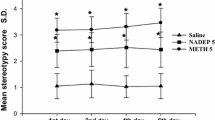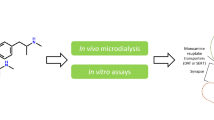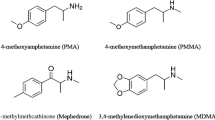Abstract
The clinical utility of amphetamine and amphetamine analogues has been jeopardized by a number of side effects and toxicity, partly due to complex mechanisms of action. While some of the analogues have been individually characterised, there is still need for comparative studies, in particular, on their efficacy to release dopamine and 5-hydroxytryptamine, further enlightening some of the synaptic mechanisms conveying their actions. Thus, we have compared four alkoxyamphetamine derivatives,i.e.,p-methoxyamphetamine;p-methoxymethamphetamine; methylenedioxyamphetamine, methylenedioxymethamphetamine, using methamphetamine, and D-amphetamine, as reference substances, on rotational behaviour and releasing mechanisms studied within vivo microdialysis in rats.
All alkoxylated-derivatives produced a long-lasting rotational behaviour at 10 mg/kg s.c., but the reference substances produced a strong rotation already at 2 mg/kg s.c. in 6-hydroxydopaminelesioned rats. At the concentration of 100 μM, the alkoxylated-derivatives were equipotent to evoke dopamine and 5-hydroxytryptamine release in rat neostriatum, while D-amphetamine and methamphetamine were more efficient on dopamine release. Pre-treatment with methamphetamine or the alkoxylated-derivatives produced a remarkable decrease of the effect of K+-depolarisation on both dopamine and 5-hydroxytryptamine release.
The insertion of a methoxy or a methylenedioxy group on the benzene ring of D-amphetamine or methamphetamine, or N-methylation of the Damphetamine molecule alters the selectivity of the compounds. The efficacy of the alkoxylated-derivatives on dopamine and 5-hydroxytryptamine release was similar, but stimulated less dopamine release and produced less rotational behaviour than Damphetamine and methamphetamine. The lower efficacy of K+-depolarisation following pre-treatments with the derivatives suggests an impairment of releasable monoamine stores. The present observations can enlighten the mechanisms of action of drugs showing a high risk for abuse among young populations.
Similar content being viewed by others
Abbreviations
- 5-HIAA:
-
5-hydroxyindoleacetic acid
- 5-HT:
-
5-hydroxytryptamine (serotonin)
- 6-OHDA:
-
6-hydroxydopamine
- D-AMPH:
-
D-amphetamine
- DA:
-
dopamine
- DOPAC:
-
dihydroxyphenylacetic acid
- HPLC:
-
highperformance liquid chromatography
- HVA:
-
homovanillic acid
- MDA:
-
methylenedioxyamphetamine
- MDMA:
-
methylenedioxymethamphetamine (Ecstasy)
- METH:
-
methamphetamine
- PMA:
-
para-methoxyamphetamine
- PMMA:
-
para-methoxymethamphetamine
References
Abekawa T, T Ohmori and T Koyama (1994) Effects of repeated administration of a high dose of methamphetamine on dopamine and glutamate release in rat striatum and nucleus accumbens.Brain Res. 643, 276–281.
Axt KJ and ME Molliver (1991) Immunohistochemical evidence for methamphetamine-induced serotonergic axon loss in the rat brain.Synapse 9, 302–313.
Brown JM, GR Hanson and AE Fleckenstein (2000) Methamphetamine rapidly decreases vesicular dopamine uptake.J. Neurochem. 74, 2221–2223.
Brunswick DJ, S Benmassour, SM Tejami-Butt and M Hauptmann (1992) Effects of high-dose methamphetamine on monoamine uptake sites in rat brain measured by quantitative autoradiography.Synapse 11, 287–293.
Buchanan JF and CR Brown (1988) “Designer drugs” a problem in clinical toxicology.Med. Toxicol. 3, 1–17.
Burrows KB, WL Nixdorf and BK Yamamoto (2000) Central administration of methamphetamine synergizes with metabolic inhibition to deplete striatal monoamines.J. Pharmacol. Exp. Ther. 292, 853–860.
Bustamante D, Y Zhi-Bing, MN Castel, S Johansson, M Goiny, L Terenius, T Hökfelt and M Herrera-Marschitz (2002) Effect of repeated methamphetamine treatment on neurotransmitter release in substantia nigra and neostriatum of the rat.J. Neurochem. 83, 645–654.
Bustamante D, G Díaz-Véliz, C Paeile, G Zapata-Torres and BK Cassels (2004) Analgesic and behavioral effects of amphetamine, p-methoxyamphetamine and N-alkyl-p-methoxyamphetamine derivatives.Pharmacol. Biochem. Behav. 79, 199–212.
Butcher SP, IS Fairbrother, JS Kelly and GW Arbuthnott (1988) Amphetamine-induced release in the rat striatum: an in vivo microdialysis study.J. Neurochem. 50, 346–355.
Byard RW, J Gilbert, R James and RJ Lokan (1998) Amphetamine derivate fatalities in South-Australia. Is “ecstasy” the culprit?Am. J. For. Med. Pathol. 19, 261–265.
de la Torre R, J Ortuño, M Mas, M Farre and J Segura (1999) Fatal MDMA intoxication.Lancet 353, 593.
Eisch AJ, SJ O’Dell and JF Marshall (1996) Striatal and cortical NMDA receptors are altered by a neurotoxic regimen of methamphetamine.Synapse 22, 217–225.
Felgate HE, PD Felgate, RA James, DN Sims and DC Vozzo (1998) Recent paramethoxyamphetamine deaths.J. Anal. Toxicol. 22, 69–172.
Fibiger HC and EG McGeer (1971) Effect of acute and chronic methamphetamine treatment on tyrosine hydroxylase activity in brain and adrenal medulla.Eur. J. Pharmacol. 16, 176–180.
Fleckenstein AE, RR Metzger, JW Gibb and GR Hanson (1997) A rapid and reversible change in dopamine transporters induced by methamphetamine.Eur. J. Pharmacol. 323, 9–10.
Frey K, M Kilbourn and T Robinson (1997) Reduced striatal vesicular monoamine transporters after neurotoxic but not after behaviorally-sensitizing doses of methamphetamine.Eur. J. Pharmacol. 334, 273–279.
Fuxe K and U Ungerstedt (1970) Histochemical biochemical and functional studies on central monoamine neurons after acute and chronic amphetamine administration, In:Amphetamine and Related Compounds (Costa E, Ed.) (Raven Press:New York), pp 257–288.
Gough B, SZ Imam, B Blough, W Slikker Jr and SF Ali (2002) Comparative effects of substituted amphetamines (PMA, MDMA, and METH) on monoamines in rat caudate: a microdialysis study.Ann. NYAcad. Sci. 965, 410–420.
Green AR, AO Mechan, JM Elliott, E O’Shea and MI Colado (2003) The pharmacology and clinical pharmacology of 3,4-methylenedioxymethamphetamine (MDMA, “ecstasy” ).Pharmacol. Rev. 55, 463–508.
Haughey JM, AE Fleckenstein, RR Metzger and GR Hanson(2000) The effects of methamphetamine on serotonin transporter activity: role of dopamine and hyperthermia.J. Neurochem. 75, 1608–1617.
Herrera-Marschitz M and U Ungerstedt (1984a) Evidence striatal efferents relate to different dopamine receptors.Brain Res. 323, 269–278.
Herrera-Marschitz M and U Ungerstedt (1984b) Evidence that apomorphine and pergolide induce rotation in rats by different actions on D1 and D2 receptor sites.Eur. J. Pharmacol. 98, 165–176.
Herrera-Marschitz M, H Utsumi and U Ungerstedt (1990) Scoliosis in rats with experimentally-induced hemiparkinsonism: dependence upon striatal dopamine denervation.J. Neurol. Neurosurg. Psychiatr. 53, 39–43.
Herrera-Marschitz M, JJ Meana, WT O’Connor, M Goiny, MS Reid and U Ungerstedt (1992) Neuronal dependence of extracellular dopamine, acetylcholine, glutamate, aspartate and gammaaminobutyric acid (GABA) measured simultaneously from rat neostriatum usingin vivo microdialysis, reciprocal interactions.Amino Acids 2, 157–179.
Herrera-Marschitz M, Z-B You, M Goiny, JJ Meana, R Silveira, O Godukhin, Y Chen, S Espinoza, E Pettersson, F Loidl, G Lubec, K Andersson, I Nylander, L Terenius and U Ungerstedt (1996) On the origin of extracellular glutamate levels monitored in the basal ganglia byin vivo microdialysis.J. Neurochem. 66, 1726–1735.
Holson RR, JF Bowger, P Clausing and B Bough (1996) Methamphetamine-stimulated striatal dopamine release declines rapidly over time following microdialysis probe insertion.Brain Res. 739, 301–307.
Hotchkiss AJ and JW Gibb (1980) Long-term effects of multiple doses of methamphetamine on tryptophan hydroxylase and tyrosine hydroxylase activity in rat brain.J. Pharmacol. Exp. Ther. 214, 257–260.
Johansen SS, AC Hansen, IB Muller, JB Lundemose and MB Franzmann (2003) Three fatal cases of PMA and PMMA poisoning in Denmark.J. Anal Toxicol. 27, 253–256.
Johnson M, AA Letter, K Merchant, GR Hanson and JW Gibb (1988) Effects of 3,4-methylenedioxyamphetamine and 3,4-methylenedioxymethamphetamine isomers on central serotonergic, dopaminergic and nigral neurotensin systems of the rat.J. Pharmacol. Exp. Ther. 244, 977–982.
Kalant H (2001) The pharmacology and toxicology of ecstasy (MDMA) and related drugs.Can. Med. J. Assn. 165, 917–928.
Kleven MS and LS Seiden (1992) Methamphetamine-induced neurotoxicity: structure activity relationships.Ann. NY Acad. Sci. 654, 292–301.
Kraner JC, DJ McCoy, MA Evans, LE Evans and BJ Sweeney (2001) Fatalities caused by the MDMA-related drug paramethoxyamphetamine (PMA).J. Anal. Toxicol. 25, 645–648.
Kuczenski R and DS Segal (1992) Differential effects of methamphetamine and dopamine uptake blockers (cocaine, nomifensine) on caudate and accumbens dialysate dopamine and 3-methoxytyramine.J. Pharmacol. Exp. Ther. 262, 1085–1094.
Kuczenski R, D Segal, AK Cho and W Melega (1995) Hippocampus norepinephrine, caudate dopamine and serotonin, and behavioural responses to the stereoisomers of amphetamine and methamphetamine.J. Neurosci. 15, 1308–1317.
Lebsanft HB, A Mayerhofer, KA Kovar and WJ Schmidt (2003) Is the esctasy-induced ipsilateral rotation in 6-OHDA unilaterally lesioned rats dopamine independent?J. Neural Transm. 110, 707–718.
Marek GJ, G Vosmer and LS Seiden (1990) Dopamine uptake inhibitors block long-term neurotoxic effects of methamphetamine upon dopaminergic neurons.Brain Res. 513, 274–279.
Marshall JF, SJ O’Dell and FB Weihmuller (1993) Dopamine-glutamate interactions in methamphetamine-induced neurotoxicity.J. Neural Transm. 91, 241–254.
Martin TL (2001) Three cases of fatal paramethoxyamphetamine overdose.J. Anal. Toxicol. 25, 649–651.
Nash JF and BK Yamamoto (1992) Methamphetamine neurotoxicity and striatal glutamate release: comparison to 3,4-methylenedioxymethamphetamine.Brain Res. 581, 237–243.
Nichols DE (1986) Differences between the mechanism of action of MDMA, MBDB, and the classic hallucinogens. Identification of a new therapeutic class: entactogens.J. Psychoactive Drugs 18, 305–313.
Nixdorf WL, KB Burrows, GA Gudelsky and BK Yamamoto (2001) Enhancement of 3,4-methylenedioxymethamphetamine neurotoxicity by energy inhibitor malonate.J. Neurochem. 77, 647–654.
O’Dell SJ, FB Weihmuller and JF Marshall (1991) Multiple methamphetamine injections induce marked increases in extracellular striatal dopamine which correlate with subsequent neurotoxicity.Brain Res. 564, 256–260.
Paxinos G and C Watson (1982)The Rat Brain in Stereotaxic Coordinates (Academic Press:San Diego, CA).
Peat MA, PF Warren, C Bakhit and JW Gibb (1985) The acute effects of methamphetamine and p-chloro-amphetamine on the cortical serotonergic system of the rat brain: evidence for differences in the effects of methamphetamine and amphetamine.Eur. J. Pharmacol. 116, 11–16.
Pentney AR (2001) An exploration of the history and controversies surrounding MDMA and MDA.J. Psychoactive Drugs 33, 213–221.
Pu C and CV Vorhees (1993) Developmental dissociation of methamphetamine-induced depletion of dopaminergic terminals and astrocytes reaction in rat striatum.Dev. Brain Res. 72, 325–328.
Pu C, EJ Fisher, GP Cappon and CV Vorhees (1994) The effects of amfonelic acid, a dopamine uptake inhibitor, on methamphetamine-induced dopamine terminal degeneration and astrocytic response in rat striatum.Brain Res. 649, 217–224.
Randrup AS and I Munkvad (1966) Role of catecholamines in the amphetamine excitatory response.Nature 211, 540.
Ricaurte GA, CR Schuster and LS Seiden (1980) Long-term effects of repeated methylamphetamine administration on dopamine and serotonin neurons in the rat brain: a regional study.Brain Res. 193, 153–163.
Sabol KE, JT Roach, SL Broom, C Ferreira and MM Preau (2001) Long-term effects of a high-dose methamphetamine regimen on subsequent methamphetamine-induced dopamine releasein vivo.Brain Res. 892, 122–129.
Schmidt CJ (1987) Acute administration of methylenedioxyamphetamine: comparison with the neurochemical effects of itsN-desmethyl andN-ethyl analogues.Eur. J. Pharmacol. 136, 81–88.
Schmidt CJ and JW Gibb (1985) Role of the dopamine uptake carrier in the neurotoxic response to methamphetamine: effect of amfonelic acid.Eur. J. Pharmacol. 109, 73–80.
Seiden LS, CR Fischman and CR Schuster (1976) Long-term methamphetamine-induced changes in brain catecholamines in tolerant rhesus monkeys.Drug Alcohol Dependend. 1, 215–219.
Sonsalla PK, WJ Nicklas and RE Heikkila (1989) Role for excitatory amino acids in methamphetamine-induced nigrostriatal dopaminergic toxicity.Science 243, 398–400.
Steele TD, JC Katz and GA Ricaurte (1992) Evaluation of the neurotoxicity of N-methyl-1-(4-methoxyphenyl)-2-aminopropane (para-methoxymethamphetamine, PMMA).Brain Res. 589, 349–352.
Stephans SE and BK Yamamoto (1994) Methamphetamineinduced neurotoxicity: roles for glutamate and dopamine efflux.Synapse 17, 203–209.
Stone DM, DC Stahl, GR Hanson and JW Gibb (1986) The effects of 3,4-methylenedioxymethamphetamine (MDMA) and 3,4- methylenedioxyamphetamine (MDA) on monoaminergic systems in the brain.Eur. J. Pharmacol. 128, 41–48.
Stone DM, M Johnsson, GR Hanson and JW Gibb (1987) A comparison of the neurotoxic potential of methylenedioxyamphetamine (MDA) and its N-methylated and N-ethylated derivatives.Eur. J. Pharmacol. 134, 245–248.
Tseng L-F, MK Menon and HH Loh (1976) Comparative actions of the monomethoxyamphetamines on the release and uptake of biogenic amines in brain tissue.J. Pharmacol. Exper. Ther. 197, 263–271.
Ungerstedt U (1971) Striatal dopamine release after amphetamine or nerve degeneration revealed by rotationalbehaviour.Acta Physiol. Scand. 367, 49–68.
Ungerstedt U and GW Arbuthnott (1970) Quantitative recording of rotational behaviour in rats after 6-hydroxydopamine lesions of the nigrostriatal dopamine system.Brain Res. 24, 485–493.
Ungerstedt U, M Herrera-Marschitz, U Jungnelius, L Ståhle, U Tossman and T Zetterström (1982) Dopamine synaptic mechanisms reflected in studies combining behavioural recordings and brain dialysis.Adv. Biosci. 37, 219–231.
Zetterström T, T Sharp, CA Marsden and U Ungerstedt (1983)In vivo measurement of dopamine and its metabolites studied by intracerebral dialysis: changes after D-amphetamine.J. Neurochem. 41, 1769–1773.
Zetterström T, M Herrera-Marschitz and U Ungerstedt (1986) Simultaneous measurement of dopamine release and rotational behaviour in 6-hydroxydopamine denervated rats using intracerebral dialysis.Brain Res. 376, 1–7.
Author information
Authors and Affiliations
Corresponding author
Rights and permissions
About this article
Cite this article
Romero, C.A., Bustamante, D.A., Zapata-Torres, G. et al. Neurochemical and behavioural characterisation of alkoxyamphetamine derivatives in rats. neurotox res 10, 11–22 (2006). https://doi.org/10.1007/BF03033330
Received:
Revised:
Issue Date:
DOI: https://doi.org/10.1007/BF03033330




